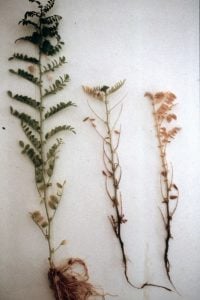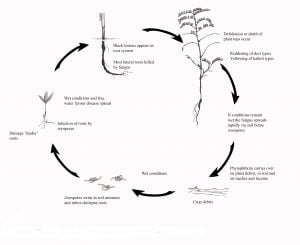Phytophthora root rot is a serious constraint to production in northern New South Wales but is rarely seen in southern Australia. It poses a potential threat to chickpea production in wetter regions.
What to Look For
The disease is usually observed late in the season but may also affect young plants. Badly affected seedlings suddenly wither and die with no obvious disease symptoms.
Infected plants are often stunted with obvious yellowing and drying of the foliage. They have few lateral roots and the lower portion of the tap root is often decayed. The remaining tap root is usually discoloured dark brown to black. Sometimes the discolouration can extend to the base of the plant. The advancing margins of the lesions may also have a reddish-brown discolouration. The disease can often be mistaken for waterlogging, but with Phytophthora the lower leaves yellow first and have often dropped off unlike waterlogging which affects the whole plant.

Healthy chickpea plant (far left), compared to phytophthora infected plants. Note lack of lateral roots and discoloured root tissue
Disease Cycle
Phytophthora root rot, a fungal disease caused by the oomycete Phytophthora medicaginis, survives in soil, plant debris and on other hosts, in particular, lucerne.
The disease has been severe in fields where previous lucerne stands have been affected by phytophthora root rot. In wet soils, spores of the fungus are released and attack the developing roots of susceptible plants. If soils remain wet the disease rapidly spreads to other plants.
Management
It is important to avoid soils prone to waterlogging and land where previous lucerne crops were affected by root rot. The incidence and severity of the disease can sometimes be reduced by fungicidal seed treatment. Some varieties have moderate resistance.
Once Phytophthora is identified in a paddock nothing can be done in that season to control the disease or protect the crop. The best control method where the disease is identified is crop rotations by not growing chickpeas or lucerne, and after, monitoring inoculum levels with a soil-borne test. Metalaxyl based seed treatments can provide some level of control, but crop rotations are the best form of control.
Hosts
Phytophthora medicaginis has been observed within chickpea and lucerne crops within Southern Australia with other crops providing a good alternative where the pathogen is present.



